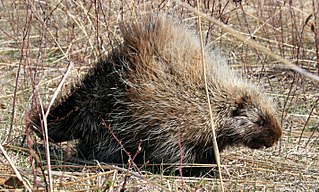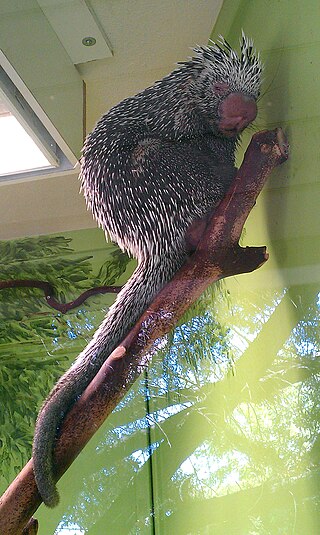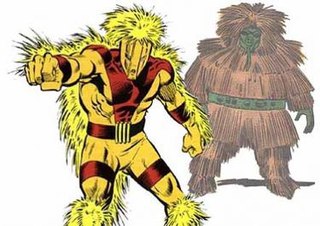
Porcupines are large rodents with coats of sharp spines, or quills, that protect them against predation. The term covers two families of animals: the Old World porcupines of the family Hystricidae, and the New World porcupines of the family Erethizontidae. Both families belong to the infraorder Hystricognathi within the profoundly diverse order Rodentia and display superficially similar coats of rigid or semi-rigid quills, which are modified hairs composed of keratin. Despite this, the two groups are distinct from one another and are not closely related to each other within the Hystricognathi. The largest species of porcupine is the third-largest living rodent in the world, after the capybara and beaver.

The New World porcupines, family Erethizontidae, are large arboreal rodents, distinguished by their spiny coverings from which they take their name. They inhabit forests and wooded regions across North America, and into northern South America. Although both the New World and Old World porcupine families belong to the Hystricognathi branch of the vast order Rodentia, they are quite different and are not closely related.

The Old World porcupines, or Hystricidae, are large terrestrial rodents, distinguished by the spiny covering from which they take their name. They range over the south of Europe and the Levant, most of Africa, India, and Southeast Asia as far east as Flores. Although both the Old World and New World porcupine families belong to the infraorder Hystricognathi of the vast order Rodentia, they are quite different and are not particularly closely related.

Porcupine Tree are an English rock band formed by musician Steven Wilson in 1987. During an initial career spanning more than twenty years, they earned critical acclaim from critics and fellow musicians, developed a cult following, and became an influence for new artists. The group carved out a career at a certain distance away from mainstream music, being described by publications such as Classic Rock and PopMatters as "the most important band you'd never heard of".

Steven John Wilson is an English musician. He is the founder, guitarist, lead vocalist and songwriter of the rock band Porcupine Tree, as well as being a member of several other bands, including Blackfield, Storm Corrosion and No-Man. He is also a solo artist, having released seven solo albums since his solo debut Insurgentes in 2008. In a career spanning more than 30 years, Wilson has made music prolifically and earned critical acclaim. His honours include six nominations for Grammy Awards: twice with Porcupine Tree, once with his collaborative band Storm Corrosion and three times as a solo artist. In 2017 The Daily Telegraph described him as "a resolutely independent artist" and "probably the most successful British artist you've never heard of".

The North American porcupine, also known as the Canadian porcupine, is a large quill-covered rodent in the New World porcupine family. It is the second largest rodent in North America after the North American beaver. The porcupine is a caviomorph rodent whose ancestors crossed the Atlantic from Africa to Brazil 30 million years ago, and then migrated to North America during the Great American Interchange after the Isthmus of Panama rose 3 million years ago.

The Porcupine Mountains, or Porkies, are a group of small mountains spanning the northwestern Upper Peninsula of Michigan in Ontonagon and Gogebic counties, near the shore of Lake Superior. The Porcupine Mountains were named by the native Ojibwa people, supposedly because their silhouette had the shape of a crouching porcupine. They are home to the most extensive stand of old growth northern hardwood forest in North America west of the Adirondack Mountains, spanning at least 31,000 acres (13,000 ha). The area is popular among tourists, especially Lake of the Clouds in the heart of the mountains, and is part of Porcupine Mountains Wilderness State Park.

Caviomorpha is the rodent infraorder or parvorder that unites all New World hystricognaths. It is supported by both fossil and molecular evidence. The Caviomorpha was for a time considered to be a separate order outside the Rodentia, but is now accepted as a genuine part of the rodents. Caviomorphs include the extinct Heptaxodontidae, the extinct Josephoartigasia monesi and extant families of chinchilla rats, hutias, guinea pigs and the capybara, chinchillas and viscachas, tuco-tucos, agoutis, pacas, pacaranas, spiny rats, New World porcupines, coypu and octodonts.

The Cape porcupine, Cape crested porcupine or South African porcupine, is a species of Old World porcupine native to central and southern Africa.

The Indian crested porcupine is a hystricomorph rodent species native to southern Asia and the Middle East. It is listed as Least Concern on the IUCN Red List. It belongs to the Old World porcupine family, Hystricidae.

Hystrix is a genus of porcupines containing most of the Old World porcupines. Fossils belonging to the genus date back to the late Miocene of Africa.

The prehensile-tailed porcupines or coendous are found in Central and South America. Two other formerly recognized Neotropical tree porcupine genera, Echinoprocta and Sphiggurus, have been subsumed into Coendou, since Sphiggurus was shown by genetic studies to be polyphyletic, while Echinoprocta nested within Coendou.

The brush-tailed porcupines are a genus, Atherurus, of Old World porcupines found in Asia and Africa.

The crested porcupine, also known as the African crested porcupine, is a species of rodent in the family Hystricidae native to Italy, North Africa and sub-Saharan Africa.

The Porcupine caribou(Rangifer tarandus groenlandicus) is a herd or ecotype of barren-ground caribou, the subspecies of the reindeer or caribou found in Alaska, United States, and Yukon and the Northwest Territories, Canada.
Porcupine Meadows Provincial Park is a 2,704 hectare provincial park in British Columbia, Canada, located north of Tranquille Lake to the northwest of Kamloops. Its name is a direct translation of the Shuswap word for this area, "pisitsoolsia", named so for the numerous porcupine in the area.

Porcupine is the name used by two fictional characters appearing in American comic books published by Marvel Comics: Alexander Gentry, a weapons designer who uses his porcupine battlesuit in an attempt to become wealthy through crime, as one of the first costumed professional criminals of his generation, and Roger Gocking, a criminal who purchased the suit to commit crimes, before joining the Thunderbolts and reforming, joining Ben Urich and Jessica Drew as a private investigator, and as nanny to the latter's son Gerry, before eventually coming to date Jessica himself.
In a zoological context, spines are hard, needle-like anatomical structures found in both vertebrate and invertebrate species. The spines of most spiny mammals are modified hairs, with a spongy center covered in a thick, hard layer of keratin and a sharp, sometimes barbed tip.
Porcupine Plain is a town in Saskatchewan, Canada. It is accessed by Highway 23. Greenwater Lake Provincial Park is 5 kilometres (3.1 mi) southwest on Highway 38. The town is located within the Porcupine Provincial Forest. The town was originally settled by returning World War I veterans who settled in the area during the early 1920s. Quilly Willy is the town mascot used on promotional material. Porcupine Plain is the hometown of Calgary Hitmen play-by-play man Brad Curle, St. Louis Blues alumnus Kelly Chase, Paralympic athlete Colette Bourgonje, and TSN SportsCentre sportscaster Darren Dutchyshen, and the company Sweet Pure Honey.
The Porcupine Provincial Forest is a protected boreal forest in Canada which covers the Porcupine Hills on the border of Saskatchewan and Manitoba.














